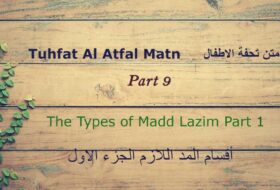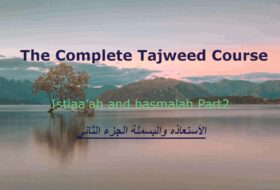The Rulings of Madd أحـــكــام الـــــمــد
See:-> Part-1 Part-2 Part-3 Part-4 Part-5 Part-6 Part-7 Part-9 Part-10 Part-11
أحكام المد
لِلْمَــدَّ أَحْكَـــامٌ ثَلاثَةٌ تَـدُومْ وَهْيَ الوُجُوبُ وَالجـوَازُ وَاللُّزُومْ
فَـوَاجبٌ إِنْ جَاءَ همــزٌ بَعْدَ مَدّ فِي كِلْمَة وَذَا بِمُتَّصِـــلْ يـُعَدَّ
وَجَـائزٌ مَـــدٌ وَقَصَرٌ إِنْ فُصِلْ كُـلٌّ بِكِلْمَةٍ وهَذَا المنْفَصِـــلْ
ومـثلُ ذَا إن عَــرضَ السُّكُونُ وَقْفـاً كَتَعْلَمُونَ نَستْعَيِــــنُ
أَوْ قُـــدَّمَ الهَمْزُ عَلَي الَمدَّ وَذَا بَدَلْ كَآمنُوا وِاِيمَانـــاً خُـذَا
وَلازِمٌ إنِ السُّكُـــــونُ أُصَّلاً وَصْلاً وَوَقْفاً بَعْدَ مَدًّ طُــوَّلاً
TEXT: 42
لِلْمَــدَّ أَحْكَـــامٌ ثَلاثَةٌ تَـدُومْ وَهْيَ الوُجُوبُ وَالجـوَازُ وَاللُّزُومْ
VOCABULARY:
لِلْمَــدَّ – for the madd
أَحْكَـــامٌ – rulings
تَـدُومْ – from stemming, always
الوُجُوبُ – compulsory
وَالجـوَازُ – permissible
وَاللُّزُومْ – necessary
TRANSLATION:
42. For the madd there are always three rules, they are: wujub (compulsory), jawaz (permissible) and luzūm (necessary).
COMMENTARY:
There are always three rulings, which are attached to the different types of madd farʿi; those which are compulsory (wajib) to make those which are permissible (jāʾiz) to make, and those which are necessary (lazim) to make.
In the following lines the author outlines the various madd farʾi individually, and the ruling it will fall under.
TEXT: 43
فَـوَاجبٌ إِنْ جَاءَ همــزٌ بَعْدَ مَدّ فِي كِلْمَة وَذَا بِمُتَّصِـــلْ يـُعَدَّ
VOCABULARY:
فَـوَاجبٌ – so wajib
مَدّ – literally means pull, however, here it refers to a letter of madd.
كِلْمَة – a word. It may be read with a fatḥah or kasrah on the kāf.
وَذَا – َshort for which means this.
بِمُتَّصِـــلْ – ِas muttaṣil (the joined madd).
يـُعَدَّ – counted as i.e. considered as
TRANSLATION:
43. So (it is) compulsory if a hamzah appears after a (letter of) madd in one word. And this (madd) is counted as muttasil
COMMENTARY:
The ḥukm of madd muttasil is that it is wajib; compulsory to pull, according to all the qurra. The qurra do however have differences of opinion as to how long the madd should be pulled. According to the narration of Ḥafs via the ṭarīq of the Shaṭibiyyah, it should be pulled 4 or 5 ḥaraka He also defines madd muttaṣil: when the letter of madd is followed by a hamzah in the same word.
TEXT: 44
وَجَـائزٌ مَـــدٌ وَقَصَرٌ إِنْ فُصِلْ كُـلٌّ بِكِلْمَةٍ وهَذَا المنْفَصِـــلْ
VOCABULARY:
وَجَـائزٌ – permissible, allowed
مَـــدٌ وَقَصَرٌ – َpull (madd) or shorten (qaṣr)
فُصِلْ – separate
كُـلٌّ – each i.e. the letter of madd and the hamzah
بِكِلْمَةٍ – word a inِ
المنْفَصِـــلْ – munfaṣil (the separated madd)
TRANSLATION:
44. And it (madd) is jaʾiz: to pull or to shorten, if each (the letter of madd and the hamzah) is separate in a word (of their own). And this (madd) is munfaṣil.

COMMENTARY:
The author first explains that if a ḥukm is jaʾiz, madd and qaṣr will be allowed in it. The definition of madd has already been given previously. Qaṣr literally means to shorten. Technically, it is to read the letter of madd or the letter of leen without any bit of extra pull in it (only for the duration of two ḥarakat.
Therefore if any madd has this ḥukm, the reader will be allowed to pull it longer than two ḥarakāt or to shorten it, reading it with two ḥarakat only .
There are three madds that fall under this ruling. The first one, madd munfasil, is explained in this verse. The letter of madd and the hamzah are separated where the letter of madd appears at the end of one word and the hamzah comes at the beginning of the next word.
Since madd munfaṣil is jaʾiz, it is allowed to be pulled for theduration of 4 or 5 ḥarakat in the narration of Ḥafs via the ṭarīq of the Shaṭibiyyah. Qaṣr will also be allowed in madd munfaṣil due toit being jaʾiz. However, this will only be allowed in the narration of Ḥafṣ via the ṭariq of the Ṭayyibah .
TEXT: 45
ومـثلُ ذَا إن عَــرضَ السُّكُونُ وَقْفـاً كَتَعْلَمُونَ نَستْعَيِــــنُ
VOCABULARY:
ومـثلُ – like this (the previous ḥukm)
ذَا – short for which means this.
عَــرضَ – appears, presents itself. It indicates something temporary.
وَقْفـاً – due to waqf (stop)
TRANSLATION:
45. And like this, (madd will be jaʾiz) when the sukun is temporary due to waqf like (in the examples) تَعْلَمُونَ and نَستْعَيِــــنُ
COMMENTARY:
If waqf is made on words like تَعْلَمُونَ and نَستْعَيِــــنُ then the last letter is read with a sukun. The sukun is temporary since it only appears during waqf. During waṣl (joining), the last letter will be read with a ḥarakah instead .
If there is a letter of madd before the temporary sukun, then it is
known as madd ʿariḍ li al-sukun (temporary madd due to a sukūn) or madd ʿāriḍ li al-waqf (a temporary madd due to waqf).
The author explains that the hukm regarding this madd is the same as madd munfaṣil i.e. jaʾiz. Thus it would be allowed to make madd and qaṣr in it. Qaṣr would be 2 ḥarakat, whereas madd would include both tawassuṭ and ṭul.
TEXT: 46
وَلازِمٌ إنِ السُّكُـــــونُ أُصَّلاً وَصْلاً وَوَقْفاً بَعْدَ مَدًّ طُــوَّلاً
VOCABULARY:
أَوْ – or
قُـــدَّمَ – before
وَذَا – َshort for which means this.
َبَدَلْ – substitute, replace. It may be read with a fatḥah on the dal and the laam as sakin (بَدَلْ ( or with the dal as sakin and a ḍammatain on the lam ( بَدَلْ
خُـذَ – word is originally خُـذَ , which means take .
TRANSLATION:
46. Or (madd will be jaʾiz if) the hamzah is before the (letter of) madd. And this (madd) is badal like آمنُوا and وِاِيمَانـــاً so take (them as examples).
COMMENTARY:
This is the third madd with a ḥukm that is jaʾiz: madd badal (the substitute madd). In madd muttasil and munfaṣil the hamzah comes after the letter of madd. In madd badal however, the hamzah appears before the letter of madd e.g. آمنُوا and وِاِيمَانـــاً
Badal means to substitute or replace. It is called the substitute madd because a letter of madd is substituted for a hamzah. These word were originally آمنُوا and وِاِيمَانـــاً A letter of madd replacesthe second hamzah which is sakinah in each one of these examples;
thus it substitutes the hamzah and is therefore called madd badl (the substitute madd).
Since this madd is also jaʾiz, madd and qaṣr are allowed in it. Qaṣr will be made according to all the qurrāʾ, including Ḥafs. Madd willonly be allowed in the narration of Warsh. It will include both tawassuṭ and ṭul .
TEXT: 47
وَلازِمٌ إنِ السُّكُـــــونُ أُصَّلاً وَصْلاً وَوَقْفاً بَعْدَ مَدًّ طُــوَّلاً
VOCABULARY:
وَلازِمٌ – necessary
أُصَّلاً – regarded as original/permanent
وَصْلاً وَوَقْفاً – during waqf and waṣl
طُــوَّلاً – ُto lengthen, prolong. Technically, tul means to pull madd to the duration of 6 ḥarakāt or 5/3 alifs .
TRANSLATION:
47. And (madd will be) lazim if the sukūn is permanent (when) during waqf and wasl after the letter of madd, ṭul is made (in it).
COMMENTARY:
Since the ḥukm of this madd is lazim, the madd has also been named lazim. Its duration is ṭul only.
Madd lazim is when the letter of madd is followed by a permanent sukon. A permanent sukun is that sukon which remains during wasl or waqf e.g. ق وَالْقُرْآنِ الْمَجِيدِ
During waqf and waṣl, the faʾ of ق – قاف will have a sukon.
learn-pillars-of-islam
islamic-studies
4-tips-on-how-to-learn-arabic-successfully-part2














Comments